On May 17 and 18th, we held the 2nd annual Maker Educator Convening at The Crucible in Oakland, CA. The two-day national event brought together roughly 175 formal and informal educators from across the country and the world, with the goal of connecting and deepening the collective impact of maker education.
For attendees of the event, one highlight was the keynote talk given by Nichole Pinkard, founder of the Digital Youth Network in Chicago.
Here are 6 takeaways from that keynote:
“Learning is a lifestyle connected to identity”
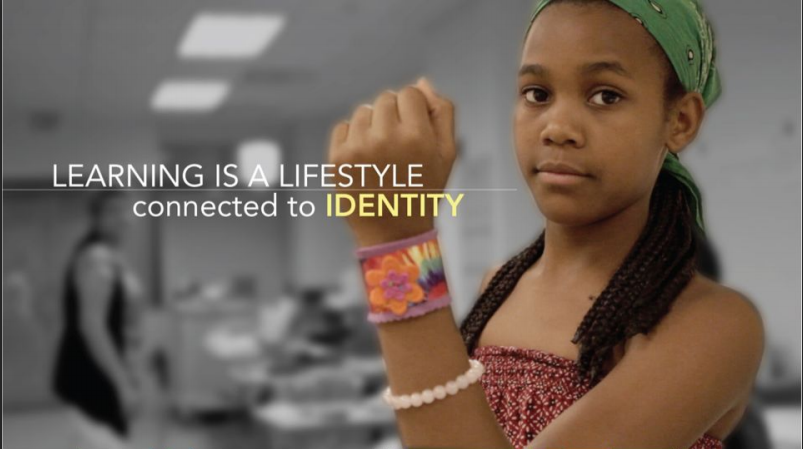
Identity was the centerpiece of this keynote talk. Nichole made the point that in order for youth to feel passionate about learning and to feel that they have the power to create changes in their world, they need to feel like learning and making are a part of who they are.
She identified three factors that motivate youth to adopt a maker identity — role models, access, social capital — and went into each of these more deeply throughout her talk.
Maker identity develops with Role Models, Access to tools and mentors,identity needs to be valued socially. N. Pinkard #MakerEdConvening
— Donna from ReCreate (@reCREATEorg) May 18, 2016
Create a “sometimes it is okay to chill” space without creating a “chill only” space
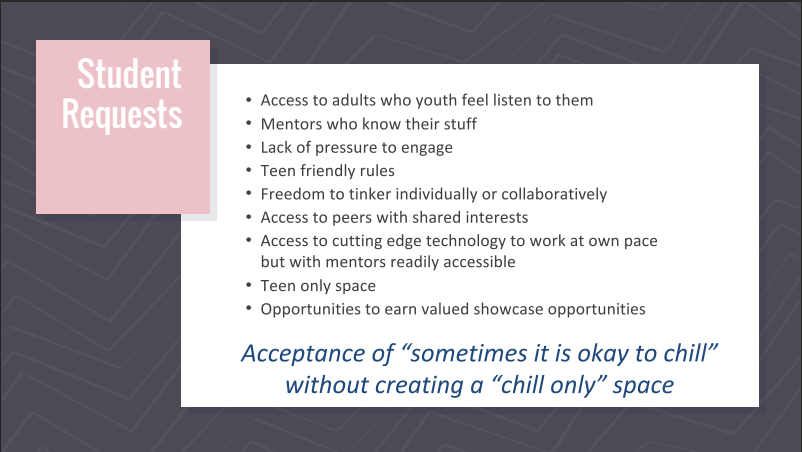
Nichole emphasized the importance of designing spaces that create a sense of belonging for youth with a wide spectrum of experiences, backgrounds, and personalities. To do so, she recommends listening to youth, hearing their needs, and taking their voices into account when designing your space. She shared a set of requests she received from students in her space (see list above) and discussed a student who felt like he needed a space to “chill.” She suggested to the audience that it was important to create spaces and experiences where youth could just “chill,” where the needs they see as important are being met actively, but also introduce young people to new new ways to take action and get involved.
Like basketball courts, makerspaces should offer multiple entry points for youth
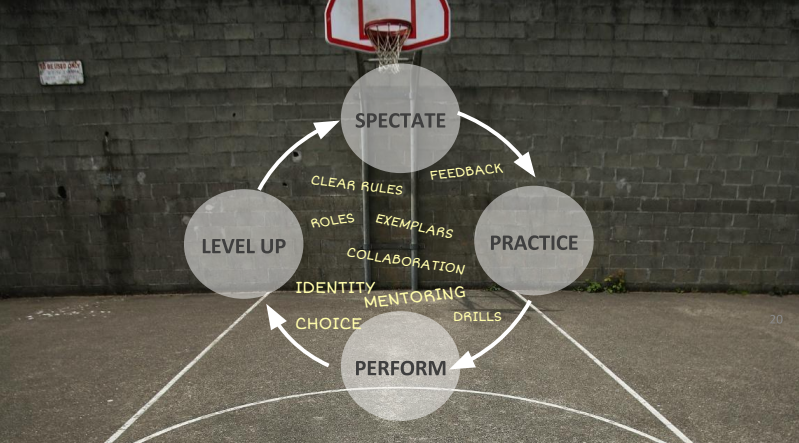
Similarly, Nichole shared the idea that spaces should be flexible enough to enable youth to find a place for themselves. Using the analogy of a basketball court, she pointed out how a space could be designed to enable youth to participate in multiple ways — since, on a basketball court, participants can join in by practicing, playing, leveling up or watching from the sidelines. On the court, all of these roles are valued, and are seen as entry points for involvement in the activity. A makerspace should operate with the same principles. There are many ways to participate, all of which are valuable and contribute positively to the makerspace community.
Like a basketball court, create spaces where you can play, practice, level up, or spectate. –@npinkard #MakerEdConvening
— Josh Weisgrau (@jweisgrau) May 18, 2016
“No one aspires to be what they can’t see” (or the importance of diverse role models and stories)
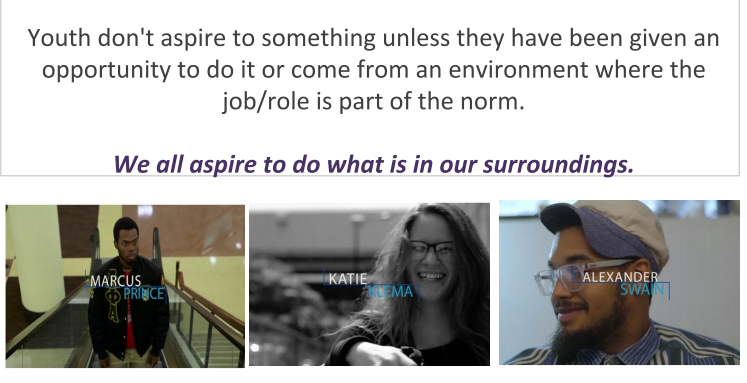
Again speaking about identity and its relation to maker-centered learning, Nichole talked about how important it is for youth to have access to role models and stories of young makers with whom they identify.
As an example of this, she shared a video profiling a student from the Digital Youth program named Jalen who started as a middle school student. As Jalen went through the program, he came to identify as an artist — and Nichole highlighted how important it is for other youth to hear Jalen’s experience and perspective as they develop their own identities as artists and makers.
She also emphasized that Jalen’s story was just one of many. She encouraged the audience to capture and share the stories of multiple youth, so that youth with different backgrounds, perspectives and personalities could feel represented.
Alongside capturing multiple stories, she encouraged educators to tell those stories in multiple ways. Because video can be a time and resource-intensive medium to get right, she encouraged using other media — text, audio, and photos — to tell stories as well.
#MakerEdConvening speaker Nichole Pinkard says we need to share our story so others' Ss can see themselves in what we're doing #wateachlead
— Doug Ferguson, NBCT (@DaskalosDouglas) May 18, 2016
Lastly, but most importantly, working from the premise that “you can’t be what you can’t see,” Nichole specifically called out the importance of highlighting makers of color in stories — and encouraged educators in the audience to do so.
Calling out not seeing enough people of color in the maker movement, we need to see ourselves represented #MakerEdConvening
— 𝐌𝐞𝐞𝐧𝐨𝐨 𝐑𝐚𝐦𝐢 (Taylor’s Version)🌈 (@MeenooRami) May 18, 2016
Have parents join in the making
During the Q&A session of the keynote, educators asked Nichole how to engage families in making. In order for youth to participate in Digital Youth Network programs, their parents are required to participate in family maker nights in which they create and solve problems. This, Nichole shared, has proved to be an invaluable way to engage families because parents experience first-hand the very same struggles and joys that their children experience when making — and this allows them to see the value of the program more clearly.
Consider the wider ecosystem
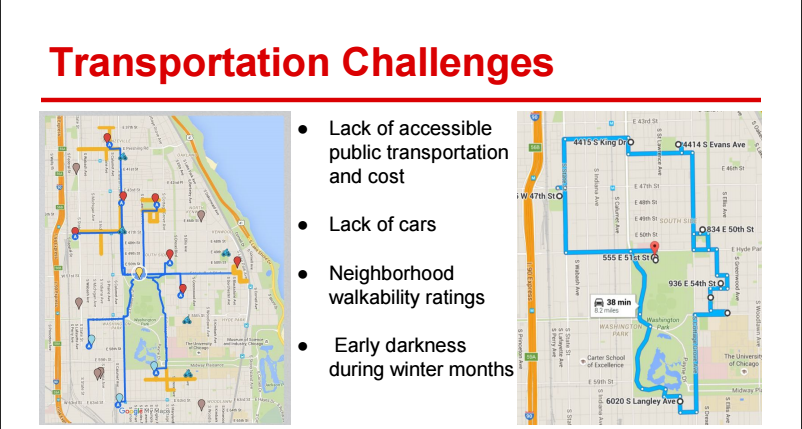
Nichole also urged attendees to consider some of the barriers that prevent equitable access to maker education programs for some youth and families — particularly those from under-resourced communities. As an example, she shared a challenge that many of her attendees face: transportation. It is often these nitty gritty details, and a lack of active planning and preparation surrounding them, that leads to a lack of diversity and equity in maker activities. Spaces must plan actively, and think about details like transportation in order to ensure a variety of voices and participants in their programs.
Learn more about Nichole Pinkard’s work by reading her latest book, The Digital Youth Network, and follow her on Twitter.

Leave a Reply